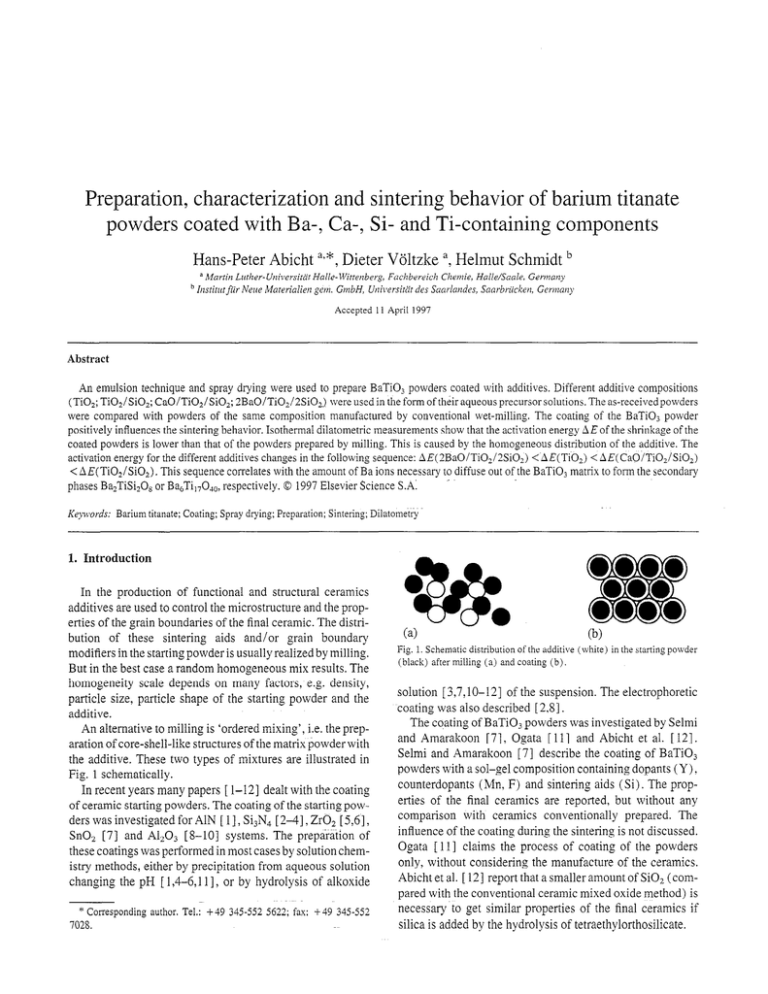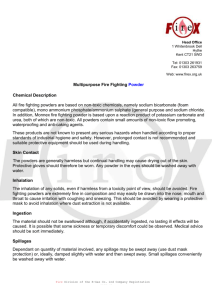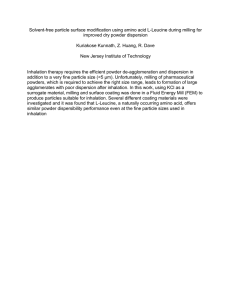Dokument 1
advertisement

Preparation, characterization and sintering behavior of barium titanate powders coated with Ba-, Ca-, Si- and Ti-containing components Hans-Peter Abicht a3*, Dieter Vijltzke ‘, Helmut Schmidt b a Martin h Imritutfiir Luther-Uirziversitri’t Neue Maten’alierz Hulk- Witter~berg, Fochbereich Chernie, Halle/Snnle, Germarty gem. GmbH, Ur7h~ersitiir des Sanrlandes, Saarbn’icken, Germnrzp Accepted11April 1997 Abstract An emulsiontechniqueand spraydrying wereusedto prepareBaTiO, powderscoatedwith additives.Different additivecompositions (TiO,; TiOJSiO,; CaO/TiOJSiO,; 2BaO/Ti0,/2SiOa wereusedin theform of theiraqueous precursorsolutions.Theas-received powders werecomparedwith powdersof the samecompositionmanufacturedby conventionalwet-milling.The coatingof the BaTi03 powder positivelyinfluencesthesinteringbehavior.Isothermaldilatometricmeasurements showthat theactivationenergyAE of theshrinkageof the coatedpowdersis lowerthanthat of the powderspreparedby milling. This is causedby the homogeneous distributionof the additive.The activationenergyfor thedifferentadditiveschanges in thefollowingsequence: AE(2BaO/Ti02/2Si0J <AE(Ti02) < AE( CaO/Ti0,/Si02) < AE(TiOz/Si02). Thissequence correlateswith theamountof Ba ionsnecessary to diffuseout of theBaTiO, matrix to form thesecondary phases Ba2TiSi208or BaOTi170.10, respectively.0 1997ElsevierScienceS.A. Keqwvrds: Bariumtitanate;Coating: Spraydrying; Preparation; Sintering; Dilatometfy 1. Introduction In the production of functional and structural ceramics additives are usedto control the microstructure and the properties of the grain boundariesof the final ceramic. The distribution of these sintering aids and/or grain boundary modifiers in the starting powder is usually realized by milling. But in the best casea random homogeneousmix results.The homogeneity scale dependson many factors, e.g. density, particle size, particle shapeof the starting powder and the additive. An alternative to milling is ‘orderedmixing’, i.e. the preparation of core-shell-like structuresof the matrix powderwith the additive. These two types of mixtures are illustrated in Fig. 1 schematically. In recent years many papers[ l-121 dealt with the coating of ceramic starting powders.The coating of the starting powderswasinvestigated for AlN [ 11, S&N, [ 2-41, ZrO, [ 5,6], SnOrz [7] and A&O3 [&lo] systems.The preparation of thesecoatingswasperformedin mostcasesby solutionchemistry methods,either by precipitation from aqueoussolution changing the pH [ 1,4-6,111, or by hydrolysis of alkoxide * Corresponding 7028. author. Tel.: +49 345-552 5622; fax: +49 345-552 (4 Fig. 1. Schematic distribution of the additive (black) after milling (a) and coating (b). (b) (white) in the starting powder solution [ 3,7, lo- 121 of the suspension.The electrophoretic coating was alsodescribed [ 2,8]. The coating of BaTiO, powders wasinvestigatedby Selmi and Amarakoon [7], Ogata [ 1l] and Abicht et al. [ 121. Selmi and Amarakoon [7] describe the coating of BaTiO, powderswith a sol-gel composition containing dopants(Y)? counterdopants(Mn, F) and sintering aids (Si). The properties of the final ceramics are reported, but without any comparison with ceramics conventionally prepared. The influence of the coating during the sintering is not discussed. Ogata [ 1l] claims the process of coating of the powders only, without considering the manufacture of the ceramics. Abicht et al. [ 121 report that a smalleramountof SiOz (compared with the conventional ceramic mixed oxide method) is necessaryto get similar properties of the final ceramics if silica is addedby the hydrolysis of tetraethylorthosilicate. 36 Table 1 Starting materials Additive for the additives composition 2BaOlTiOz/2Si0, CaOITi0,/Si02 TiOl/SiOz TiO, used in the different preparation methods Milling Spray drying, BaCO, t TiOz + SiOz CaCO, + TiO, t SiOz TiOl t SiO, or Ti02/SiOz TiOZ Ba(NO& +TiCl, -!- silica sol Ca(NOS)Z + TiCI, + silica sol TiCI fsilica sol TiCI hydrogel It is known that titania and silica additives influence the microstructure of semiconducting BaTiO, ceramics. These additives react with the BaTiO, powder during sintering. Thus, titania reacts with BaTi03 to give B%Ti,,O,,. The new system BaTiO,/Ba,Ti,,O,, forms a eutectic melt at 1320°C [ 131, In silica-containing BaTiO,-based ceramics a liquid phase forms already at about 1245°C [ 14-161. This liquid phase has the composition 24 mol% SiO?, 46 mol% BaO, 30 mol% TiOz [ 16 1, with Ba,TiSi,O, (fresnoite) being one ingredient of the eutectic mixture. The addition of calcia modifies the microstructure of BaTiO, ceramics by occupying A-sites in the perovskite ABO,, thus forming solid solutions (Ba,Ca)TiO, [ 17,181. Under certain circumstances a B-site substitution is also possible leading to drastic changes of the electric properties [ 191. In the present work here we used single- and multi-component additives to coat BaTiO, powder. TiO,, TiOz/SiOz, 2BaO/Ti0,/2SiO, (BTS) and CaO/Ti0JSi02 (CTS) precursors were chosen. The problem of chemical precipitation methods for coating of powders is to make sure that the surface of the powder itself is covered and no separate precipitation of the pure additive occurs. We used two coating methods to realize this by creating, minimizing and isolating of individual microreactors. This was done in the emulsion technique (method 1) by controlling the droptet size of the aqueous component in the organic phase, and in the spray-drying method (method 2) by the spray velocity. For the purpose of comparison the conventional milling/mixing of the starting BaTiO, powder and the additives (method 3) has also been used. 2. Experimental The BaTiO, starting powder used in this study was prepared by conventional mixed oxide technique. Mixtures of BaCO, (Leuchtstoffe und Feinchemikalien GmbH, Bad Liebenstein) and TiOz (Merck 808) were calcined for 2 h at 1lOO”C, followed by milling. For the synthesis of the aqueous solutions of the coating components the following reagent grade chemicals were used: TiCl, (Merck-Schuchardt 812382), silicas01 (Levasil2005/30%,Bayer-WerkeLeverkusen) , Ca( NO,), and Ba(NO,), (Laborchemie Apolda) The coating solutions were obtained by hydrolysis of TiCl, at about 4°C and adding of the Si, Ba and/or Ca components to the sol yielding the precursor composition TiOz, TiO,/ emulsion technique SiOp, CaO/Ti02/Si02 or 2BaO/Ti02/2Si0, respectively. Table 1 summarizes the raw materials of the additives for the different preparation methods. The aqueous coating suspensions were prepared to give 1 g BaTiOJ 10 ml coating solution. The concentrations of the coating solutions were adjusted so that the molar ratios of the coating components and the BaTiO, powder were 4:96 for the Ti0,/BaTi03, TiOz-SiO,/BaTiO, and CaO-TiO,-SiOJBaTiO, systems, and 2:98 for the 2BaO-Ti02-2Si0,/BaTi03 system, respectively. 2.1. Emulsion technkpe (method 1) A combination of suspension and emulsion was used for the coating of the BaTi03 powders. We modified the microemulsion system described by Burgard [20]. The modified system consists of petroleum ether (50-70”C)-emulsifier BRIJ-30 (ICI Specialty Chemicals)-octanol in the composition of 80: 11:9 (in vol.%). The aqueous phase (20 vol.% of petroleum ether) was loaded with the suspended BaTiO, powder and the dissolved coating components. The emulsion was prepared by stirring (5 min) the mixture of the liquids and then emulsifying (5 min) with an ultrasonic disintegrator (Fa. Branson). After that the gel formation in the aqueous phase was initiated by flowing in of gaseous NH,. A short aging time of 5-10 min followed and after the addition of 10 vol.% n-butanol (relative to the aqueous phase) the water was eliminated by azeotropic distillation. The residue was tempered at 350°C for 5 h. 2.2. Spray drying (method 2) A mini spray dryer 190 (Fa. Bi.ichi) was used. The instrumental conditions (heating, aspirator) were adjusted so that a constant input temperature of 2 10°C and an output temperature of 115°C of the air were achieved. The flow velocity of the suspension was 2.5 ml min-‘. The spray-dried powders were tempered at 350°C for 5 h to ensure comparability with the powders obtained by me&hod 1. 2.3. Milling method (method 3) The BaTi03 starting powder was mixed with the different additives in a ball mill for 24 h. The raw materials for the additives were BaCO,, TiOl, SiO, (Suprasil, precipitated silica) and CaC03 (Leuchtstoffe und Feinchemikalien GmbH, Bad Liebenstein) . In one case we used a Ti021Si0, hydrogel. This hydrogel was prepared from TiCl, sol and silica sol, gelated by addition of aqueous NH3 solution and washed until free of Cl- ions. 2.4. Clmrctcterization The coated powders were investigated using a scanning electron microscope (JEOL 6400F, equipped for energy dispersive X-ray spectrometry (EDX) ) . The particle size distribution (Shimadzu, SA-CP-3) of the powders was determined using a 0.2 wt% Na,P20,* IOH, peptisator solution. The specific surface area (BET) was measured using an ASAP-2400 (micromeritics) The sintering behavior was studied in situ by dilatometry. The powders were isostatically pressed into disks of 60% of theoretical density. The dilatometric investigations were performed with a dilatometer L75/44 (Linseis) in air with a heating rate of 10 Kmin-‘. The isothermal dilatometric measurements ( 105O”C, 1lOO”C, 115O”C, 1200°C) were carried out with a TMA 92 (Setaram) apparatus (load 1 g) . ification of barium titanate, which consists of primary particles of 500 nm size (SEM, Fig. 2, BET). The primary particles are agglomerated to a average grain size of about 1.7 km. The surface of the primary particles is smooth and the edges are well detectable and sharp. The electron micrographs of the starting powder with TiOZ/SiOz additives prepared by emulsion technique, spray drying and milling method are shown in Figs. 3-5. The powders prepared by methods 1 and 2 show a complete wrapping of the grains by the additive. The initial surface characteristic 3. Results and discussion The starting BaTiO, powder was characterizedby-XRD and SEM. It represents the highly crystalline, tetragonal mod- Fig. 2. Scanning electron micrograph of BaTiO, powder obtained by conventional mixed oxide method (BaCO, fTiO*, calcination 1 lOO”C, 2 h). Fig. 3. Scanning electron micrograph of BaTiO, prepared by emulsion technique. TiO,/SiO, powder coated with Fig. 4. Scanning electron micrograph of BaTiO, powder coated with TiOz/SiOz prepared by spray dryin g method, (a) original magnification 5000 X (b) original magnification 15000 X (Reduced in reproduction by 74%) Fig. 5. Scanning electron micrograph TiO,iSiO, hydrogelby milling. of BaTiO, powder mixed with 38 of the BaTiO, powder haschanged. The surface is slightly roughenedandthe edgesarerounded (Figs. 3 and4(b) ) . On the other hand, the microstructure of the mixture of BaTiO, andTiO,/SiO, gel obtainedby milling isillustrated in Fig. 5. It showsthe inhomogeneity of the mill-mixed powder, that is characterized by the coexistence of the original BaTiO, grainswith smoothsurfacesand smalland largegel particles. In the gel particles with a structured surface Ti and Si were detectedasmaincomponentsby EDX. The smallgelparticles are loosely depositedon the surfaceof the BaTiO, grains. The BET measurementsconfirm the covering of the surface of the starting BaTiO, powder by the additive prepared by emulsiontechnique.This is exemplarily explainedfor the CTS-coated powder. The BET surfaceof the starting BaTiO, powder was determined to be 2.63 m2g-‘; that of the pure CTS powder prepared by emulsion technique is 170.8 m* g-l. Taking into account the massratio of the two constituents in the product prepared one can calculate the specific surfaceof the resulting product with respectto two extreme situations.First, the two constituentscoexist sideby side,and secondly, the CTS additive completely covers the surfaceof the BaTiO, starting powder. The value for the first case is calculated to be 10.62 m2g-‘, whereasthat of the second caseis 8.12 m2g-l. The experimentally determinedvalue is 8.23 m* g- ‘, indicating the covering of the BaTiO, starting powder. The BET specific surfacesof the powdersprepared by method 3 aregreaterthan the valuescalculatedfor the first extreme. We explain this with the milling effect during the preparation. This milling effect wasalso proved by the grain size analysis.The averagegrain sizeof the powdersprepared by method 3 was 1.1 pm comparedto 1.7 pm in the starting powder. The averagegrain size of the spray-dried powdersisabout 4 ym. Theseparticlesrepresentagglomerates,andthe droplet size and shapeof the sprayedsuspensionare preservedin the dried product. This is clearly seenin the electron micrograph (Fig. 4(a) ) . The particlesconsistof hollow spheresof coated BaTiO, grains adheredby the coating. The main investigations were focused on the sintering behavior of the modified BaTi03 powdersin order to clarify the influence of the different preparation method and the effect of the various additives. In Fig. 6 the shrinkage curves of mixtures 96 mol% BaTiO, + 4 mol% Ti02/Si0, preparedby methods 1,2 and 3 arepresented.The coefficient of expansionis plotted versus the temperature.Becauseheating wasperformed with a constant rate the coefficient of expansionmay becorrelated with the shrinkage rate. Three t$ts are noteworthy: 1. The shrinkagerate ~1,= A (A L/Lo) /A t at the maximumis very high (c, = 2.5-5.0 X 10m4s- ’ ). Such high shrinkage ratescannot be explained by diffusion processes[2 11. If the diffusion determinesthe shrinkageprocessonly (diffusion viscous flow) shrinkagerates are supposedto be 10-8-10-5 s-l [22]. 2. The shrinkage is complete before the sintering temperature reachesthe eutectic temperatureof 1245°C(in Si02containing BaTiO, ceramics [ 14-161). The shrinkage processproceedswithout any liquid phase.The density of the compactsbelow 1245°Cis 90-958 of the theoretical density. 3. There aredistinctive differencesin the shrinkagebehavior between the powders preparedby methods 1 and 2, and the powder preparedby method 3 on the other hand. The shrinkageof the powders prepared by spray drying and emulsiontechniquestartsalready at 950°Cand hasa maximumin the shrinkagerate at 1120°C.The ‘milled’ powder lob0 30 temperature(“C) Fig. 6. Coefficient of expansion of green compacts of BaTiO, powders with TiO,/SiO, additives prepared by different methods as a function of temperature. 39 -0.05 % b i= -0.10 % 5 g -0.15 - -0.25 -+-without -a-CaO/TiO,/SiO, --a-TiO,/SiO, -2BaO/Ti042SiO, 1 I I 1100 temperature Fig. 7. Coefficient of expansion of green compacts of spray dried BaTiO, compactsbegin to shrink at 1050°Cand the maximum is at 1150°C (with a shoulderat 1100°C). Fig. 7 showsthe shrinkagebehavior of greencompactsof spray dried BaTiO, powders with different additives. It is clearly seenthat the maximum of the shrinkagerate shifts to lower temperatureswhen the BaTi03 powder is coated with SiO,-containing additives. The temperaturesof the maxima of the shrinkage rate are in the CaO/TiO,/SiO,, 2BaO/ Ti02/2Si02 and TiO,/SiO, additive system at Xt67”C, 108O”C/ 1110°C and 1120°C respectively. It is noteworthy that in the caseof the coating with the 2BaO/Ti0,/2SiO, precursor the shrinkage at low temperatures is more pronouncedthan for the other additives. Isothennal dilatometric measurementswere performed to verify the shrinkagemechanismandto quantify the activation energy for the shrinkageprocess.The simple model of Kingery [231 was usedto evaluate the experimental data. Plotting the logarithm of relative changein length, A L/L,, versusthe logarithm of time t for the different temperatures according to Eq. ( 1)) one will get a systemof curves whose slope 1/iz is related to the sintering mechanism. ALIL,=Kt”” (1) K= constant, ~2= 1 for viscous flow, }I = 2 for volume diffusion, IZ= 3 for grain boundary diffusion. The activation energy AE of densification is given by Eq. (2). K= K,,exp( - AElkT) (2) One of theseisothermal shrinkagecurves is presentedin Fig. 8. It is seenthat the shrinkageprocessis divided into two sectionsrepresenting different shrinkagemechanisms.This division into two sectionsis characteristic for all preparation methods,all usedadditives andall investigatedtemperatures. 1200 (“C) powders with different additives as a function of temperature. The slopeof the graph in the first shrinkagesection (t=O-10 min) is 1. This section is characterized by viscous flow, and representsthe main part of the whole shrinkage. In the second section (t=20-100 min) the volume and/or grain boundary diffusion is dominant ( IZ= 2-3). That meansthe whole shrinkageprocessis determinedby sliding and diffusion processes. We calculated the activation energiesA E for the first section of isothermalshrinkage.They aresummarizedin Table 2 for the powderspreparedby methods2 and 3 with different additives. Two tendenciesare visible. Firstly, the activation energiesof the spray-dried powders are lower than those of the ‘milled’ powders.Secondly, if we comparethe activation energies of the different additives we get the following sequencein both preparation methods: AE(BTS) < AE(TiO?) < AE(CTS) < AE(TiO,/SiOz) How can one explain theseexperimental results? The additives were dispersed homogeneously over the whole surfaceof the BaTiO, starting powder by spray drying and emulsion method producing an amorphousshell. These BaTiO, core-additive shellstructurespositively influencethe main shrinkagestageof sintering. From the isothermaldilatometric measurements andfrom the high value of the shrinkage rate [ 221 it may be concluded that this sintering stageis characterized by sliding of whole powder particles into the pores. Such sliding processeswere postulated and investigatedby Geguzin [ 241 and Schatt [ 251. The slidability requires a certain flexibility of the grain boundary layer, which is given by the complete covering of the surfaceand the amorphousstatusof the additive. In the ‘milled’ (method 3) powders the additives are randomly distributed in the mixture so that local similar conditions are existent as describedabove but on the other hand 40 10 1 100 time (min.) Fig. 8. Isothermal Table 2 Activation energies of the densification Preparation method Spray drying Milling shrinkage curve of spray dried mixture process of BaTiO, powders with different 96 mol% BaTiO, additives +1 mol% CaO/Ti0,1Si02 (in kJ mol- ‘) 2BaO/Ti02/2Si0, TiOz TiOJ1Si02 310.8 258.2 345.1 550.6 575.3 1262.6 most BaTiO, particles abut upon each other. The direct BaTiO,-BaTiO, contact hinders the sliding process. This is evident in the existence of two maxima in the shrinkage rate (Fig. 6) and consequently in the higher activation energy for the shrinkage. The sequence of the activation energies for the different additives one can explain as follows, In all SiO,-containing BaTiO, ceramics crystalline fresnoite ( BazTiSizOB) was found [ 12,261 as secondary phase. The lowest activation energy was determined for the 2BaO/Ti0,/2SiO, additive. With the addition of this precursor the material composition for the formation of fresnoite is given instantaneously. Fresnoite was detected in the BTS-containing powders by X-ray diffraction starting at 950°C. In the case of TiO,/SiO, and CaO/TiOJSi02, and in the case of the TiO, additives, the diffusion of Ba’ i ions out of the BaTiO, matrix is necessary to yield BazTiSi,Oy and the Ba,Ti,,O,, phase, respectively. The amount of Ba’+ ions (per unit Ti02 of the additive) required for the formation of corresponding secondary phases increases from TiO, to CaO/TiO,/SiO, and TiOJSiO,. That means the amount of diffusing Ba’+ ions influences the shrinkage behavior and correlates with the activation energy. at 1200°C. 129.0 673.8 The coating additives were applied in the form of their aqueous precursor solutions whose compositions correspond to TiOz, TiOz/SiOz, CaOITi0,/Si02 and 2BaO/Ti02/2Si0, Powders of the same composition were prepared by conventional milling of the starting BaTiO, powder and the additive to draw a parallel. The emulsion technique and the spraydrying method were found to result in covering of the surface of the BaTiO, powder by the additive, whereas milling leads to a side-by-side distribution of BaTiO, powder and additive, only. The coating of the BaTiO, powders influences the densification behavior of the compacts positively. The densification is determined by sliding and diffusion processes. Isothermal dilatometric measurements show that the activation energy A E of the densitication of the coated powders is lower than that of the powders prepared by milling. This is caused by the homogeneous distribution of the additives. The activation energy for the different additives changes in the following sequence: hE(2BaO/Ti0,/2Si02) <AE(Ti02) < AE( CaO/Ti02/SiO,) < AE( TiO,/SiOz). This sequence correlates with the amount of Ba ions necessary to diffuse out of the BaTiO, matrix to form the secondary phases Ba,TiSi,O, or BabTi ,,OJO, respectively. Acknowledgements 4. Conclusions Two techniques were investigated for coating of BaTiO, powders, a modified emulsion technique and spray drying. This work was financially supported by the Kultusministerium of Sachsen-Anhalt and the Fonds der Chemischen Industrie. 41 References [I] [2] [3] [4] [5] [6] [7] [8] [9] [ IO] [ll] W.J. Kim, Y.T. Moon, C.H. Kim, D.K. Kim and H.W. Lee, J. Mater. Sci. Len., 13 (1994) 1349. I. Malghan, S.G. Wang and A. Sivakumar, Compos. Interfaces, 1 (1993) 193. M. Kulig, W. Oroschin and P. Greil, J. Eur. Ceram. Sot., 5 ( 1989) 209. A.K. Garg and L.C. de Jonghe, J. Mater. Res., 5 (1990) 136. CL. Hu and M.N. Rahaman, J. Am. Ceram. Sot., 75 (1992) 2066. B. Djuricic, D. McGarry and S. Pickering, J. Mater. Sci. Len., 12 (1993) 1320. F.A. Selmi and V.R.W. Amarakoon, J. Am. Ceram. Sot., 71 (1988) 934. D.H. Pearce, A.J. Jickells and C.B. Ponton, in P. Duran and F. Femandez (eds.) , Third Euroceramics, Vol. 1, Faenza Editrice Iberica, 1993, p. 231. A. Meier, G. Graf and K. Dosinger, Patent No. DE 4306234, 10.03.1992, Cl C04B35100. M. Sando, M. Awano, Y. Uwamino and Y. Kuwahara, Kona (Hirakata, Jpn.), 9 (1991) 54. Y. Ogata, Patent No. JP 0558705, 09.03.1993/29.08.1991, Cl COlB35/00; Patent No. JP 0558605, 09.03.1993/29.08.1991, Cl COlB13/32. [ 121 H.-P. Abicht, H.T. Langhammer and K.-H. Felgner, J. Mater. Sci., 26 (1991) 2337. [ 131 DE. Rase and R. Roy, J. Am. Ceram. Sot., 38 (1955) 102. [ 141 Y. Matsuo and H. Sasaki, J. Am. Ceram. Sot., 54 ( 1971) 471. [ 151 D.E. Rase and R. Roy, J. Am. Ceram. Sot., 38 (1955) 389. 1161 L.M. Berberova, M.L. Sholochovic and I.N. Beliaev, Zh. Neorg. Khim., 16 (1971) 539. 1171 0. Saburi, J. Am. Ceram. Sot., 44 (1991) 54. 1181 M.B. Holmes, V.A. McCrohan and W.Y. Howng, in M.F. Yan and A.M. Heuer (eds.), Advances in Ceramics, Vol. 7, Additives and Interfaces in Electronic Ceramics, The American Ceramic Society, Columbus, OH, 1983, p. 146. [ 191 VS. Tiwati, D. Pandey, P.S.R. Krishna, R. Chakravarthy and B.A. Dasannacharya, Physica B, 174 (1991) 112. [201 D. Burgard, Diploma Thesis, Institut fir Neue Materialien, Saarbrticken, 199 1. [21] G.S. Morgan and C.J. MC Hargue, Phys. Sintering, 2 (1970) 55. [22] W. Schatt, Sintervorgange, Grundlagen, VDI, Dusseldorf, 1992, p. 73. [231 W.D. Kingety, J. Appl. Phys., 30 (1959) 301. 1241 J.E. Geguzin, Fisika Spekania, Nauka, Moscow, 1984, p. 248. 1251 W. Schatt, Z. Metallkde., 80 (1989) 809. 1261 T. Miiller and H.-P. Abicht, Thermochim. Acta, 206 (1992) 123.








